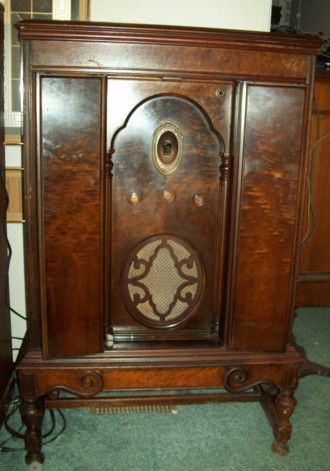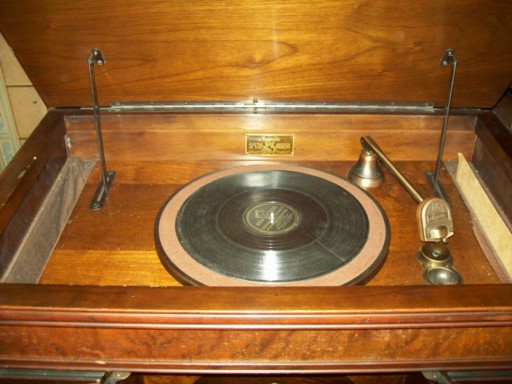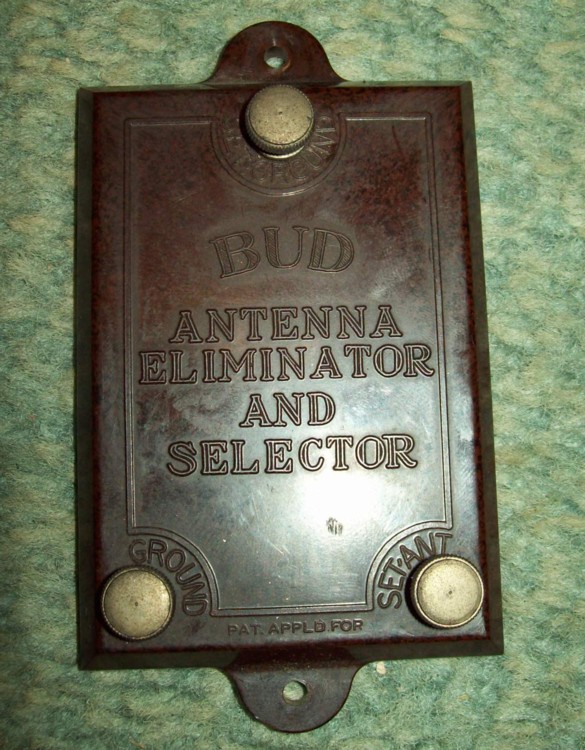Posts: 2,037
Threads: 367
Joined: Jun 2010
City: Dover, OH
I've hinted at this a few times, now I have some pictures and am posting about this radio I got in a round of big trading and dealing a couple weeks ago. This set was found at a building salvage place up north and appears to have come from a house or mansion that had been abandoned and is now a vacant lot. There is still a question who got the better end of the deal, but to score a working Majestic with all good tubes, including two very good globe 50's can't be too bad of a deal. I had another later Majestic with two 45's several years back, but just didn't like it and passed it on. This one I have really grown to like. The only head scratcher is the tuning plates. The rest of the radio seems to be really good quality from the time, but for some reason they used pot metal for the tuning plates! They have survived decently except one tiny spot where they rub, and I am not messin' with those! Anyways, pictures!


Also found this interesting item still attached inside the cabinet. Wonder how this worked?

No matter where you go, there you are.
Posts: 4,950
Threads: 54
Joined: Sep 2008
City: Sandwick, BC, CA
Warping pot metal in the tuning capacitors seems to have been a problem with many American Grigsby Grunow Majestics from that era, I haven't run into that problem in any Canadian Rogers made Majestics from those years though, even though the chassis and circuits are very similar. There are ways of repairing the problem apparently, although as with anything like that it isn't a job for those who are not mechanically inclined or have experience with such things.
Regards
Arran
(This post was last modified: 03-24-2012, 02:34 AM by Arran.)
Posts: 2,037
Threads: 367
Joined: Jun 2010
City: Dover, OH
I can't figure out why Majestic used pot metal for the tuning plates in this set. It's not a low-cost set and I have lower quality and lower cost sets from that same year that use copper plates. Even Philco used better plates. Seems someone was trying to squeeze out a little more profit at Majestic. 
No matter where you go, there you are.
Posts: 4,950
Threads: 54
Joined: Sep 2008
City: Sandwick, BC, CA
(03-24-2012, 01:03 PM)Jayce Wrote: I can't figure out why Majestic used pot metal for the tuning plates in this set. It's not a low-cost set and I have lower quality and lower cost sets from that same year that use copper plates. Even Philco used better plates. Seems someone was trying to squeeze out a little more profit at Majestic. 
The pot metal isn't in the tuning plates themselves it's in the hub that mounts the plates to the tuning condenser shaft. To my knowledge no manufacturer attempted to make condenser plates out of pot metal even back in the 20s.
Regards
Arran
Posts: 13,776
Threads: 580
Joined: Sep 2005
City: Ferdinand
State, Province, Country: Indiana
Jayce
Congratulations on your acquisition! I saw one of those at a local auction many, many years ago, when I was still living in Kentucky. Haven't seen one since. Your set has a dial like a Majestic 71. Very neat radio.
Too bad about the pot metal, but Majestic used the stuff in most if not all of their early sets.
--
Ron Ramirez
Ferdinand IN
Posts: 2,037
Threads: 367
Joined: Jun 2010
City: Dover, OH
(03-24-2012, 09:26 PM)Arran Wrote: The pot metal isn't in the tuning plates themselves it's in the hub that mounts the plates to the tuning condenser shaft. To my knowledge no manufacturer attempted to make condenser plates out of pot metal even back in the 20s.
Regards
Arran
I actually had a late 20's Crosley battery console set that had pot metal tuning vanes. Yes, they do exist and are a pain.
No matter where you go, there you are.
Posts: 2,037
Threads: 367
Joined: Jun 2010
City: Dover, OH
(03-24-2012, 09:44 PM)Ron Ramirez Wrote: Jayce
Congratulations on your acquisition! I saw one of those at a local auction many, many years ago, when I was still living in Kentucky. Haven't seen one since. Your set has a dial like a Majestic 71. Very neat radio.
Too bad about the pot metal, but Majestic used the stuff in most if not all of their early sets.
Thanks Ron!
I let go of a few sets I had fallen out of love with to get this set. Though one of those sets might be coming back my way soon. I'm surprised at how goo the push-pull 50's sound. The 10 in the Zenith 34P I let go of was a tinny sounding thing.
No matter where you go, there you are.
Posts: 337
Threads: 15
Joined: Nov 2005
City: Ortonville, MI
This Majestic is a Majestic71, that uses 27's in place of the 26's throughout the receiver chassis, then a pair of 50's in place of the 71A's as used in the 70 chassis.
The speakeris the same one as on the 71 sets, and I even think that the interstage transformers, and te output transformer are the same as on the 71.
Anyway, the power supply has a pair of 81's for the rectifiers. The 50's make that speaker earn its keep. They do to that speaker whet the 71A's can't!! I have one of these sets, amnd it really made me in love with G&G Majestics, after a lifetime of poking fun at them.
Now, on the tuning condenser. I've always been able to get a screwdriver in betwen the plates, and pry them into alignment, right at the pot metal attachment. The use of pot metal was a bonanza for manufacturers at the time, but impurities in the zinc they used caused all of that intergranular corrosion. There were some examples of good die castings, but the cheaper stuff (just look at Crosley's stuff), and there are bad examples. If you get this Majestic shaped up, you'll have a very nice set there.
Posts: 2,353
Threads: 92
Joined: May 2010
City: Clayton, NC
Hello, Jay: very nice set! I have never had a set with 50 output tubes, but have heard they are pretty good. Just hope you never have to replace them!!!
Posts: 2,037
Threads: 367
Joined: Jun 2010
City: Dover, OH
(03-25-2012, 12:57 AM)TA Forbes Wrote: Hello, Jay: very nice set! I have never had a set with 50 output tubes, but have heard they are pretty good. Just hope you never have to replace them!!!
I hope I never have to either. Previous owner rigged up a ballast resistor to drop the voltage a bit to save on things. I have read a couple places that the reason 50s are so high is that the Japanese sucked up most of them several years ago. Is that true?
No matter where you go, there you are.
Posts: 337
Threads: 15
Joined: Nov 2005
City: Ortonville, MI
Once the smoke cleared from WW II, the Japanese began to want the things that we had, and in some instances, to build their own. Certain tubes, such as the 45 and 50 were the first to be drained. I've seen "picker agents" in our radio meets, sucking up all of the stuff that the Japs pay richly for. If you want a shock, look at what a pair of Western Electric 300C tubes go for!!
Along with the 45 and 50 tubes, they also went heavily for the high ticket audio stuff, such as McIntosh, Marantz, Brook, and a few other good brands.
Fortunately, I had enough 45 and 50 tubes to supply my own sets. Some of that was foresight, but most of it was just laying in a stock of service parts for the sets I had.
(03-25-2012, 01:18 AM)Jayce Wrote: (03-25-2012, 12:57 AM)TA Forbes Wrote: Hello, Jay: very nice set! I have never had a set with 50 output tubes, but have heard they are pretty good. Just hope you never have to replace them!!!
I hope I never have to either. Previous owner rigged up a ballast resistor to drop the voltage a bit to save on things. I have read a couple places that the reason 50s are so high is that the Japanese sucked up most of them several years ago. Is that true?
Posts: 2,037
Threads: 367
Joined: Jun 2010
City: Dover, OH
Bleah, I've dealt with Japanese broker agents on eBay before, on vintage inflatable toys and inflatable promotions of all things. Had tried to get a big Uniroyal tiger years back and a couple Japanese dealers were sucking the stuff up as fast as it could be listed, for rediculous prices. I like the Japanese, but stuff like that sometimes makes me want to slap one of them. Caused a lot of flustration.
No matter where you go, there you are.
Posts: 4,950
Threads: 54
Joined: Sep 2008
City: Sandwick, BC, CA
I don't think that the type #50 tubes were that common to begin with, they had a rather short reign between the decline of the 71As in popularity and the advent of the type #45s. I know of hundreds of sets that used 71As, thousands that used a pair of #45s, but maybe a dozen models that used type 50s, RCA, Atwater Kent, Sparton, and Majestic, all top end models from 1929-31. Then after that the 45s, then the 2A3s, and 47/2A5s came about and then you're into the 6.3 volt types, which lasted until the end of the tube era
Part of the reason may be that to get the performance out of a type #50 tube you need about 400-450 VDC on the plates (especially a single ended one like soem RCAs used), which means you need close to 1 kv ac coming out of the high voltage winding, so that means a large and expensive power supply and transformer. They also needed a 7.5 volt winding, not really a big deal since it was common to use a different filament winding for the power output tube or tubes from the rest of the tubes in that era. Compare that to it's contemporary the type #45 which only needed 250 vdc, they didn't produce the same power as a pair of #50s but they were a more efficient tube.
Apparently they are making type #50s again, and with a balloon envelope, although I think anyone thinking of building an audio amp with even a new production type #50 is crazy. Sure they were the top tube to use in 1929, but there are lots of other better and less expensive tubes to experiment with, even triodes. There were valid reasons why the manufacturers stopped using them in radios, anyone who has owned a 1929 RCA with a smoked power transformer can explain it to you.
Regards
Arran
Posts: 337
Threads: 15
Joined: Nov 2005
City: Ortonville, MI
Back in the mid-twenties, the only power amplifier was the 20. Amplifier, yes; power......well hardly any.
The 10 came along during the same period, and was able to kick out around a whole 1 1/2 watts! Then, around 1928, the amplifiers appeared that used 50's in place of the 10. Both 10 and 50, by the way, used 450 jolts to get full power out of them. Power supplies were very critical, as well you might imagine, what with those halacious voltages to filter. The HV winding for the RCA Radiola 64 measures 1500 VCT!
I have a couple of Victor's Electrolas, that used a 10 to drive the speaker. I am totally astonished at the output that that feeble 10 sent to those spearkers. They were the RCA "104" electro-dynamic jobs. They sounded almost hard to believe!
I have several sets that use 50's; around 21 of them. If you poke through some of the radio mags in the 192-33 period, there are PA amplifiers that use push-pull 50's, and claim around 40 watts output. No question, they're pushing those 50 jugs well into class "B"!.
(03-26-2012, 12:05 AM)Arran Wrote: I don't think that the type #50 tubes were that common to begin with, they had a rather short reign between the decline of the 71As in popularity and the advent of the type #45s. I know of hundreds of sets that used 71As, thousands that used a pair of #45s, but maybe a dozen models that used type 50s, RCA, Atwater Kent, Sparton, and Majestic, all top end models from 1929-31. Then after that the 45s, then the 2A3s, and 47/2A5s came about and then you're into the 6.3 volt types, which lasted until the end of the tube era
Part of the reason may be that to get the performance out of a type #50 tube you need about 400-450 VDC on the plates (especially a single ended one like soem RCAs used), which means you need close to 1 kv ac coming out of the high voltage winding, so that means a large and expensive power supply and transformer. They also needed a 7.5 volt winding, not really a big deal since it was common to use a different filament winding for the power output tube or tubes from the rest of the tubes in that era. Compare that to it's contemporary the type #45 which only needed 250 vdc, they didn't produce the same power as a pair of #50s but they were a more efficient tube.
Apparently they are making type #50s again, and with a balloon envelope, although I think anyone thinking of building an audio amp with even a new production type #50 is crazy. Sure they were the top tube to use in 1929, but there are lots of other better and less expensive tubes to experiment with, even triodes. There were valid reasons why the manufacturers stopped using them in radios, anyone who has owned a 1929 RCA with a smoked power transformer can explain it to you.
Regards
Arran
Posts: 2,353
Threads: 92
Joined: May 2010
City: Clayton, NC
Hello, Doug: just curious- what kind of voltage rating do you have to look for for your filter caps? Sounds like you would have to go with some relatively expensive units to handle the high voltages.
Also, are there more than the usual power resistors there, or maybe more with a higher than usual power rating?
Users browsing this thread: 1 Guest(s)
|
|
Recent Posts
|
|
Philco Model 38-7: what caps & resistors do fail typically?
|
| Hello Martin,
Welcome aboard our little community what great Model 38-7
Sincerely Richardradiorich — 12:30 AM |
|
Philco Model 38-7: what caps & resistors do fail typically?
|
| Welcome to the Phorum Martin.
I count about 9 paper caps, the 3 electrolytic caps and 2-Y2 safety caps to replace th...RodB — 09:44 PM |
|
Part numbers to model cross
|
| Jim,
We have this index put together by Dale Cook but I don't think that is quite what you are looking for.
The Parts...klondike98 — 09:37 PM |
|
Philco Model 38-7: what caps & resistors do fail typically?
|
| Yep the dim bulb test is OK but I'd definitely replace all those electrolytics before I did it. Since those #47 conden...klondike98 — 09:18 PM |
|
Philco 42-345 Restoration/Repair
|
| The resistor is a 2.2 Meg, it was the last one I hadn't replaced. The broadcast is coming in after replacing it.osanders0311 — 09:09 PM |
|
Philco 42-345 Restoration/Repair
|
| What does the resistor measure? I think it should be 3.3 Meg.
If the oscillator coil has continuity and the resistanc...RodB — 09:03 PM |
|
Philco Model 38-7: what caps & resistors do fail typically?
|
| Good idea to check the coils... then I'll get hold of an incadescent light bulb and see what happens when the unit is sw...Musaeum — 08:49 PM |
|
Philco 42-345 Restoration/Repair
|
| I have that same set, ain't too much shortwave I like anyway.....it is a good AM DX set. PaulPaul Philco322 — 08:32 PM |
|
Philco Model 38-7: what caps & resistors do fail typically?
|
| Welcome to the Phorum, Martin! Open a new thread in Philco Electronic Restoration when you begin working on your 38-7. ...GarySP — 08:28 PM |
|
Philco Model 38-7: what caps & resistors do fail typically?
|
| Welcome to the Phorum!
:wave:
Here's the schematic for that radio from our digital library:
Something to do bef...klondike98 — 08:05 PM |
|
Who's Online
|
| There are currently no members online. |

|
 
|






![[-] [-]](https://philcoradio.com/phorum/images/bootbb/collapse.png)


